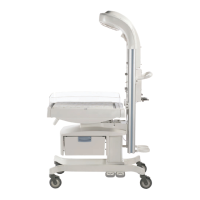Chapter 4: Troubleshooting
Troubleshooting Tables
4-26 Service Manual
4.4.2.5 One Bulb Does Not Light
4.4.2.6 Both Bulbs Do Not Light
Possible Causes Step Troubleshooting Procedure Comments
Bad bulb 1. Remove observation light assembly. Bladed screwdriver
2.
Disconnect bulb from socket. Test bulb with Ohm
Meter (should be < 1 Ohm).
3. Replace bulb if continuity test fails.
Bad harness/ bad
socket
4.
Open rear cover and disconnect harness at J26 on
Power PCA.
Open in lamp wiring 5.
With all bulbs installed, check continuity at harness
pins 1-3, and 2-4.
East side bulb:
pins 1, 3
West side bulb:
pins 2, 4
Short in lamp wiring 6.
With all bulbs removed, check for open at harness
pins 1-3, and 2-4.
7.
If either continuity test fails, remove upper housing
and troubleshoot wiring.
Bad socket 8.
Disconnect 2 pin connector located behind bulb
socket. With new bulb installed, check continuity
through bulb (should be < 4 Ohms).
Bulb socket
harness part #:
6600-1594-700
9. If continuity test fails, replace bulb socket harness.
Bad harness
connection
10.
Check that connectors at transformer harness
(J24), dimmer pot (J25), and observation lights (J26)
on the Power PCA are seated properly.
Possible Causes Step Troubleshooting Procedure Comments
1. Check lamp wiring. (Refer to steps 4-6 above.)
No Mains to
transformer
2.
Open rear cover and disconnect transformer
harness (J24) at Power PCA.
3.
Using DMM, check for Mains voltage at J24 pins 3
and 4 on the Power PCA with dimmer pot turned
on.
Bad Dimmer Pot
switch
4.
If no Mains, verify switch in Dimmer Pot Harness.
(Refer to 4.4.2.3 above.)
Bad Fuse 5.
If no Mains, check fuses F11 and F12 on Power
PCA.
Bad relay on Power
PCA
6. If fuses and Dimmer Pot OK, replace Power PCA
Bad transformer 7.
Re-connect transformer harness (J24) at Power
PCA. Transformer output must have at least one
good bulb attached to check output (lamp voltage).

